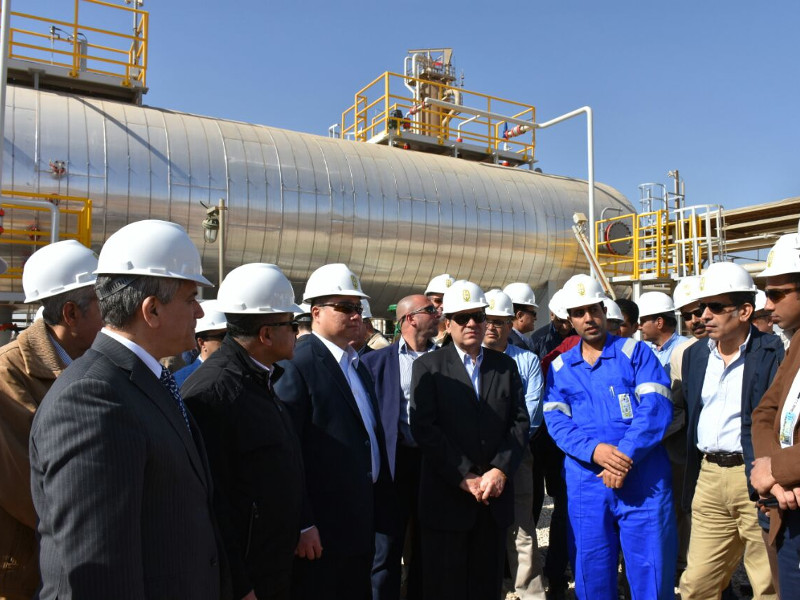
Location : Idku, Alexandria, Egypt
Capacity : 7.2Mtpa
Investment : $2bn
Commissioning : 2005
Development Partners : Shell, EGPC, EGAS, Petronas, and EngieMORE
The Egyptian LNG project, also known as the Idku LNG plant, is located approximately 50km east of Alexandria, Egypt. It consists of two natural gas liquefaction trains with a combined capacity to produce 7.2 million tonnes of LNG per annum (Mtpa).
Although commissioned in 2005, the Idku LNG export facility has been operating below its nameplate capacity due to lack of sufficient domestic gas production.
However, the LNG terminal, which is capable of exporting up to ten billion cubic metres (bcm) of gas to the global market, is expected to reach its full capacity by the end of 2019, with the surge in domestic gas production.
The production ramp-up at the facility will also help Egypt to regain its position as a net LNG exporting country.
Egyptian LNG project owner and operator
The Egyptian Liquefied Natural Gas Company (ELNG) holds ownership of the project site and common facilities for both LNG trains of the facility, while its subsidiary Egyptian Operating Company for Natural Gas Liquefaction Projects (ELNG-OPCO) is responsible for the operation of both the trains as well as common facilities.
ELNG is a joint venture of two state-owned firms, namely the Egyptian General Petroleum Corporation (EGPC) and Egyptian Natural Gas Holding Company (EGAS), and three international stakeholders including Shell, Petronas, and Engie.
El Beheira Natural Gas Liquefaction Company (EBNGL), a joint venture between Shell (35.5%), Petronas (35.5%), EGAS (12%), EGPC (12%), and Engie (now a subsidiary of Total, 5%), owns the first train of the Egyptian LNG.
Whereas, the ownership of the second train is held by the Idku Natural Gas Liquefaction Company (INGL), which comprises Shell (38%), Petronas (38%), EGAS (12%), and EGPC (12%).
Egyptian LNG project background
In 1995, BG group, in collaboration with Edison International, signed a concession agreement with the Egyptian General Petroleum Corporation (EGPC) to explore the West Delta Deep Marine (WDDM) region in the Mediterranean Sea.
A substantial amount of natural gas was discovered in the region in the five years that followed, which prompted the government to include new provisions in the original concession agreement allowing export of gas as LNG to the rest of the world.
The BG group was acquired by Shell in February 2016.
The WDDM concession currently has more than 19 gas fields, of which 12 fields, namely Scarab, Saffron, Simian, Sienna, Sapphire, Serpent, Saurus, Sequoia, SimSat-P2, Sapsat-1, Sapsat-2, and Swan, are in production.
BP’s ongoing West Nile Delta gas project development and the ramping up of production from Eni’s Zohr gas field in the Mediterranean Sea that came on stream in December 2017, are expected to further aid the export potential of the Idku LNG facility.
Egyptian LNG train-1 details
In January 2002, BLNG signed a 20-year purchase agreement with Engie (formerly, GDF) for supplying gas from the region and subsequently started constructing the first 3.6Mtpa LNG train at Idku with an estimated investment of $1.12bn.
The first shipment carrying 129,000m³ of LNG from the Egyptian LNG train-1 took place in May 2005.
Egyptian LNG train-2 details
Development of the second 3.6Mtpa train at the project site began in 2003, following INLG’s agreement with BG for selling all of its produce from the second train in September 2003.
Construction of the second train involved an investment of approximately $965m. The first cargo from the train-2 set sail on September 2005.
The operation of Egyptian LNG train-2 was, however, stalled in 2014, following the fall in gas production and rising political unrest in the country. It is expected to be restarted in 2019.
Egyptian LNG infrastructure facilities
Encompassing 165ha, the project site lies 3km away from Idku town, along the Mediterranean Sea coast of Egypt.
Primary infrastructure facility for the project includes two cryogenic tanks with 140,000m³ gas storage capacity each and a marine terminal with loading jetty and associated marine facilities.
Both the trains share common support utilities including a power generation unit, a fire water plant, and a control room.
The marine terminal for the Idku LNG facility consists of a marine building and platform, along with a 2.4km-long access trestle supported on steel pipes. The loading platform comprises loading arms, breasting and mooring dolphins, and a berth for the tugs.
Details of the liquefaction technology used at Idku
The Egyptian LNG facility uses the ConocoPhillips’ proprietary Optimized Cascade liquefaction technology as part of a license agreement signed in March 2003.
The process utilises three multi-staged cascaded refrigerant circuits using pure refrigerants, brazed aluminium heat exchangers, and insulated cold box modules.
The heat exchangers and cold box modules can be customised as per requirement. Depending upon the composition of the natural gas feed, additional units such as the heavies’ removal unit (HRU) and nitrogen rejection unit (NRU) can be easily integrated with the existing setup.
Financing
The European Investment Bank granted $372m (€304m) loan to EBNGL for the construction of train-1 in December 2003.
Contractors involved
Bechtel was the engineering, procurement, and construction contractor for both the LNG trains at Idku, while Petrojet and Enppi, two affiliates of Egyptian General Petroleum Corporation (EGPC), were engaged as subcontractors.
A joint venture between Mitsubishi Heavy Industries and VINCI Construction Grands Projects, was the EPC contractor for two storage tanks and ancillary buildings for the facility, while Hassan Allam Construction was engaged as a major subcontractor.
Insultec was contracted to provide a turnkey solution for hot and cold insulation for the LNG train equipment and pipelines.
Italian engineering design and consulting firm Tecon performed the front-end engineering and design (FEED) study of the marine terminal.
Source: https://www.nsenergybusiness.com/projects/egyptian-lng-project-idku/

.png)
